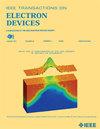Impacts of Postdeposition Annealing on Interface Properties of HfO2/Si0.7Ge0.3 Gate Stacks With TMA Predoping
IF 2.9
2区 工程技术
Q2 ENGINEERING, ELECTRICAL & ELECTRONIC
引用次数: 0
Abstract
The impacts of postdeposition annealing (PDA) on the electrical characteristics and structural properties of HfO2/Si0.7Ge0.3 gate stacks using trimethylaluminum (TMA) predoping are investigated in detail. The interface state density (沉积后退火对掺杂 TMA 的 HfO2/Si0.7Ge0.3 栅极叠层界面特性的影响
研究了沉积后退火(PDA)对三甲基铝(TMA)预掺杂HfO2/Si0.7Ge0.3栅极堆电学特性和结构性能的影响。在PDA作用下,界面态密度(${D} _{\text {it}}$)在$300~ ${\circ}$ C到$600~ ${\circ}$ C之间先减小后增大。与$300~ ${\circ}$ C相比,$400~ ${\circ}$ C的最小值${D} _{\text {it}}$为$8\乘以$ 10^{{11}}$ eV $^{-{1}} \cdot $ cm $^{-{2}}$,这是因为在界面处Ge-O键的形成得到了更有效的抑制。当PDA温度进一步升高到$500~^{\circ}$ C和$600~^{\circ}$ C时,Al向HfO2中的扩散导致Al- o键的形成数量增加,Al- o网络中的氧缺陷促进了额外的氧向界面扩散,导致形成更多的GeO,从而导致${D} _{\text {it}}$的恶化。
本文章由计算机程序翻译,如有差异,请以英文原文为准。
求助全文
约1分钟内获得全文
求助全文
来源期刊

IEEE Transactions on Electron Devices
工程技术-工程:电子与电气
CiteScore
5.80
自引率
16.10%
发文量
937
审稿时长
3.8 months
期刊介绍:
IEEE Transactions on Electron Devices publishes original and significant contributions relating to the theory, modeling, design, performance and reliability of electron and ion integrated circuit devices and interconnects, involving insulators, metals, organic materials, micro-plasmas, semiconductors, quantum-effect structures, vacuum devices, and emerging materials with applications in bioelectronics, biomedical electronics, computation, communications, displays, microelectromechanics, imaging, micro-actuators, nanoelectronics, optoelectronics, photovoltaics, power ICs and micro-sensors. Tutorial and review papers on these subjects are also published and occasional special issues appear to present a collection of papers which treat particular areas in more depth and breadth.
 求助内容:
求助内容: 应助结果提醒方式:
应助结果提醒方式:


